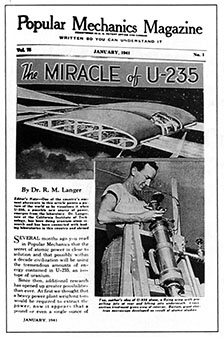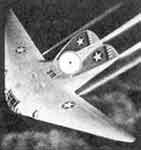 |
In its August 25, 1945 issue, Newsweek published this (probably pre-war) image of a conceptual "atomic-powered" flying wing. The amount of radioactive fuel needed to propel this craft, according to the article, was represented by the circled dot |
Nuclear Energy for the Propulsion of Aircraft
Oak Ridge, Project SIGN and the hunt for radioactive UFOs
The Manhattan Project had considered the possibility of powering ships and aircraft with nuclear energy, but with most of its creative energy focused on designing bombs, it reportedly did little serious work on non-weapon applications during the war.
See: Ulam's Atomic Saucer
In order to begin to understand the issues resulting from placing a reactor in an airplane, and to help uncover unanticipated problems, in the spring of 1946 the Army Air Force established a project called NEPA -- Nuclear Energy for the Propulsion of Aircraft -- under contract to Fairchild Engine and Airplane Corporation. Known more for its stodgy cargo planes and trainers than for prowess in radically advanced technology, Fairchild seemed ill-suited for the project. The company produced many reports and conducted crude experiments -- placing radium in the bomb bay of a B-29 and measuring the radiation field in the cockpit with geiger counters, and so on -- but made little real progress toward building an actual nuclear-powered airplane.
In 1947, at the height of the flying saucer wave of early July, a sensational article on an alleged "atomic-powered" Russian saucer appeared in the Los Angeles Examiner. According to the story, a "top-flight nuclear physicist" in Los Angeles had received a mysterious letter containing a description of the Soviet saucer from someone associated with an officer of a Russian oil tanker which was docked in Los Angeles harbor. The letter claimed to describe a "kidney-shaped" aircraft, just eighteen inches thick, with a highly polished surface. The pilot was said to lay prone in a cockpit that was cooled against the heat produced by the saucer's tremendous speed. "The lifting force is an entirely new principle, found about 10 years ago among the unpublished papers of a Russian chemist," the story claimed. "Energy is required only for climbing, but no energy is needed for support when the airplane goes along the earth's gravitational contour lines." The letter was supposedly turned over to the FBI.
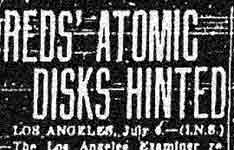 |
For a revealing look at the continued poor quality of press reports about the real Soviet nuclear aircraft project a decade later, and an example of the kind of feverish speculation that sometimes overcame US analysts who were under pressure to prevent repeats of surprises like the unanticipated launch of Sputnik 1, see The Soviet "Nuclear-Powered Bomber" Fiasco of 1958 click to enlarge |
While the 1947 Examiner "Red Atomic Disk" story had more in common with contemporary pulp science fiction tales than with genuine nuclear aircraft concepts, concerns about real Soviet nuclear-powered aircraft, and the problems inherent in transporting American bombs to Soviet targets, were beginning to stimulate serious nuclear propulsion development efforts in the US.
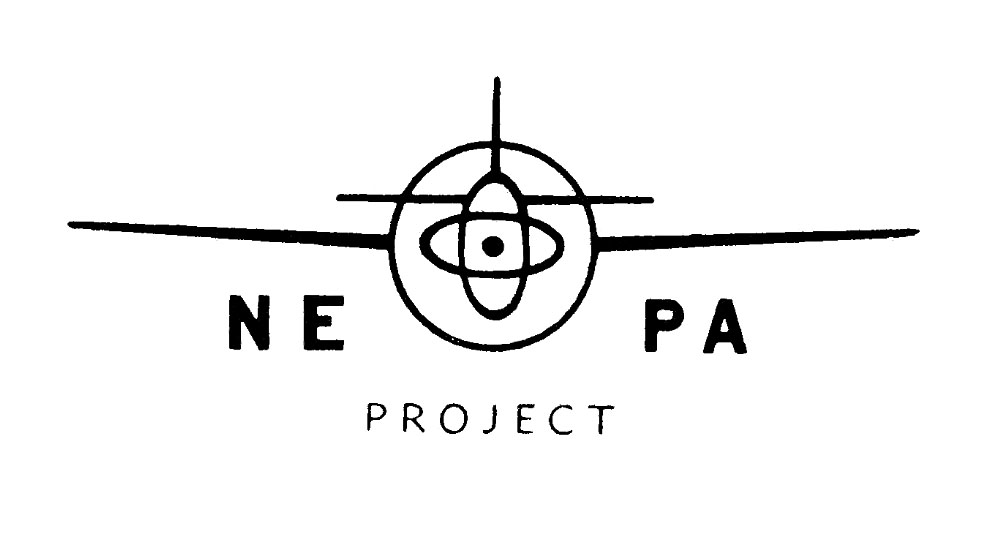 |
NEPA project logo, July 1947
DOE |
In 1948, an MIT summer study conference called the "Lexington Project" carried out the first thorough engineering survey of the problems of applying nuclear reactors to aircraft propulsion. It concluded in its final report ("LEX P-1") that the idea was technically achievable on a practical basis (although it would be far from easy and it might take 15 years to produce a flying aircraft), and that two different approaches to the goal seemed apparent. These dealt with the "cycles" used by the jet engines -- "open" or "closed" thermodynamic cycles. In both cases, the heat of the reactor was transferred to the propulsion engine by some working medium. In the open cycle, the turbojet engine's air was the medium, and would simply flow through the reactor, which functioned as a replacement for the combustion chamber where fuel was burned in an ordinary engine. In a closed cycle, a fluid of some type, possibly molten metal, would circulate between the reactor and a heat exchanger ahead of the turbine. While vastly more complex in engineering terms, the closed cycle eliminated air as a heat transfer medium and promised much higher engine efficiencies.
While it seemed self-evident that nuclear power would be ideal for airplanes -- who wouldn't want an aircraft that would never have to land? -- in reality the practical challenges were almost insurmountable. Although progress was being made at the time with development of reactors for ships and submarines, little of the nautical reactor program's technical knowledge was directly applicable to aircraft powerplants. The sheer mass of a reactor and its ancillary systems and structure meant that only the largest planes could carry such a poweplant, and big planes were inherently ponderous and slow. Could the reactor's heat be transferred efficiently to the engines? Could the reactor be cooled properly and controlled effectively in flight? Looming over all these questions were problems with the extremely powerful radiation emitted by the reactor -- it would congeal most lubricants, destroy the structural strength of airframe materials, and damage electronics, and of course, it was lethal to the airplane's crew.
Because of these problems, one of the ideas considered by the Lexington group was to simply eliminate the crew from the nuclear airplane, make it into a flying atomic tugboat, and let it tow a more conventional airplane -- safely distanced from the reactor by a long cable -- to the vicinity of a target.
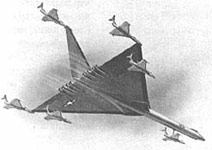 |
Northrop concept for nuclear-powered bomber with six air-launchable defensive "parasite fighters," c. 1952
|
Other researchers realized that some of these shielding problems could be circumvented through the use of hot radioisotopes -- essentially a form of nuclear waste -- rather than a nuclear reactor, as a concentrated heat source for nuclear engines. These radical engine concepts may have been what Project SIGN's engineers had in mind when they theorized about advanced atomic engines for man-made saucers.
See: Radioisotope-powered nuclear aircraft
On April 27, 1949, a conference was held at Oak Ridge National Laboratory, Tennessee (ORNL), between NEPA contractors, the Air Force, and AEC personnel, with the intent to plan Oak Ridge participation in the NEPA project. The ORNL NEPA effort was called the Aircraft Nuclear Propulsion project (ANP) and was established under Air Materiel Command project officer Lt Col Clyde D. Gasser.
See: NEPA History 1
ANP was a more vigorous program than the original NEPA project, and really began to seriously tackle the many problems posed by nuclear flight. Fairchild was dropped as the prime contractor and major design efforts began at Lockheed and Convair's Fort Worth division. While many types of engines were studied by ANP, including giant propellers driven by steam turbines, as of 1951-2 the Air Force's vision of an operational nuclear-powered bomber centered on the mammoth Convair YB-60, a swept-wing, turbojet-powered modification of the B-36 strategic bomber. It was a far cry from Newsweek's compact 1945 flying wing. NEPA's July 1947 report had set its sights on the goal of building an aircraft in the 300,000 lb gross weight range, with a speed of 515 mph at 35,000 ft and a weapon load of 12,000 lb. The B-60 closely followed those criteria.
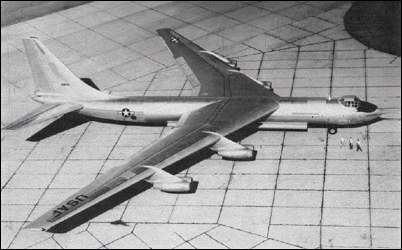 |
YB-60 prototype, Spring 1952 |
The nuclear powerplant designed for the B-60 was the General Electric P-1, an air-cycle reactor with a thermal output probably in the 50 megawatt range, which was married to four powerful GE XJ53 turbojet engines by a complex tangle of air ducts. The reactor would be cooled both by the airflow from the turbojets and by boron-laced shielding water circulating through its shell. As the XJ53 had a rated thrust of about 17,500 lb, the four nuclear-heated engines would have had approximately the same thrust as all eight conventional J57s on the rival Boeing XB-52.
Air from the turbojet compressors would flow directly through the reactor core, where it would be heated to some 2,000 degrees F before being returned to the engine turbine sections. Though this was a relatively simple and direct method of constructing the nuclear engine, it had the drawback of producing an exhaust plume that might contain radioactive debris eroded from the reactor core, and other contaminants.
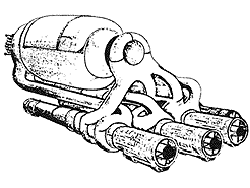 |
 |
 |
A prototype GE X39 nuclear-heated turbojet, based on the J47 used in the B-47 bomber, shows air duct scrolls for connection to the reactor (arrows). With a thrust output of between 5,000 and 7,000 lb, this engine was used for ground testing of reactor prototypes and probably would have been used for early flight testing of the nuclear propulsion powerplant |
The P-1 reactor/X39 engine complex would have been flight tested aboard a highly modified B-36 bomber known as the X-6. The P-1 would have been installed in the X-6's bomb bay for flight and removed shortly after landing by taxying the plane over a huge pit equipped with an elevator that would lower the engine into a shielded isolation area to reduce irradiation of the airframe, crew and ground personnel. The model (below) shows the four X39 pods protruding from the belly of the X-6.

When the P-1 engine was applied to the actual B-60 production nuclear-powered bomber, the reactor/J53 engine complex apparently would have been installed in the aft bomb bay area of the fuselage, as far as possible from the crew compartment. The arrows, below, indicate the probable location of the engine assembly. (The B-60 flew numerous times powered by conventional turbojets, but never with the nuclear engines). Heavy shielding was planned, consisting of tanks of a water-boron solution (boron-10 isotope is an excellent neutron absorber), plastics (possibly polyethylene with boron or lead additives) and layers of metal such as lead, steel and tungsten. The crew compartment itself would have had additional shielding. This "divided shielding" concept was considered one of the major technical breakthroughs of the early NEPA project.

The aircraft probably would have retained its conventional jet engines for use during takeoff and landing. Once airborne and away from populated areas, the crew would bring the reactor up to power and the aircraft would cruise on nuclear heat. The intention was to create an aircraft with nonstop around-the-world range, endurance measured in days, and near sonic speed, all while carrying a heavy nuclear weapon payload.
See: Project SIGN and radioactive UFOs
